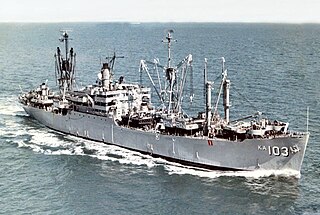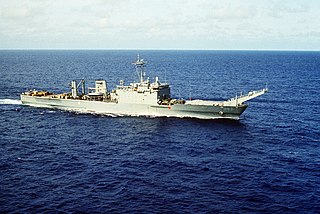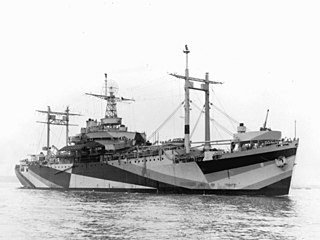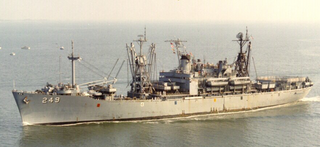
The Iwo Jima-class amphibious assault ships of the United States Navy were the first amphibious assault ships designed and built as dedicated helicopter carriers, capable of operating up to 20 helicopters to carry up to 1,800 marines ashore. They were named for battles featuring the United States Marine Corps, starting with the Battle of Iwo Jima. The first ship of the class was commissioned in 1961, and the last was decommissioned in 2002. The hull classification of "LPH" stands for "Landing Platform Helicopter".

USS Frederick (LST-1184) was a Newport-class tank landing ship which replaced the traditional bow door-design tank landing ships (LSTs) of the United States Navy. The ship was named after the city of Frederick, Maryland and Frederick County, Maryland. The vessel entered service in 1970 with the United States Pacific Fleet and saw service during the Vietnam War, and the Persian Gulf War earning three battle stars. The ship was decommissioned in 2002 and put up for sale.

Amphibious cargo ships were U.S. Navy ships designed specifically to carry troops, heavy equipment and supplies in support of amphibious assaults, and to provide naval gunfire support during those assaults. A total of 108 of these ships were built between 1943 and 1945—which worked out to an average of one ship every eight days. Six additional AKAs, featuring new and improved designs, were built in later years. They were originally called Attack Cargo Ships and designated AKA. In 1969, they were renamed as Amphibious Cargo Ships and redesignated LKA.

Newport-class tank landing ships were an improved class of tank landing ship (LST) designed for and employed by the United States Navy from 1969 to 2002. The ships were intended to provide substantial advantages over their World War II-era predecessors. Larger and faster than any previous LST design, they carried a ramp over the bow that allowed them to surpass 20 knots, a goal of the United States amphibious forces. 27 were planned of which twenty were completed, the high number due to the demands of US force projection estimates. However, the arrival of the air-cushioned landing craft which allowed for over-the-horizon attacks made the class obsolete in the eyes of the United States Navy. Placed in reserve, twelve were eventually sold to foreign navies, while the remaining eight have since been decommissioned.

USS Tuscaloosa (LST-1187) was the ninth of the Newport-class tank landing ships of the United States Navy, which replaced the traditional bow door-design tank landing ships (LSTs). The vessel was constructed by the National Steel and Shipbuilding Company in San Diego, California and was launched in 1969 and commissioned in 1970 and the second ship of the United States Navy to be named after the city of Tuscaloosa, Alabama. The LST participated in the Vietnam War and was decommissioned in 1994. The ship was laid up until being sunk as a target ship during a sinking exercise in 2014.

USS Newport (LST-1179) was the third ship of the United States Navy (USN) to bear the name of the Rhode Island city. The first of her class of landing ship tanks (LST), she was capable of a sustained speed of 20 knots. Her ability to adjust her draft, accompanied by her unique bow-ramp design, helped bring a new degree of responsiveness to the amphibious fleet. The ship was launched in 1968 and entered service with the USN in 1969. Assigned to the United States Atlantic Fleet for the entirety of her career, Newport made deployments to the Mediterranean and Caribbean Seas. The vessel was taken out of service in 1992 and laid up until 2001.

The Anchorage-class dock landing ships were a series of five dock landing ships (LSD) constructed and commissioned by the United States Navy between 1965 and 1972. US Navy decommissioned all five of them by 2003. They are succeeded by Whidbey Island-class LSDs and Harpers Ferry-class LSDs.

USS Peoria (LST-1183) was a Newport-class tank landing ship which replaced the traditional bow door-design tank landing ships (LSTs). The vessel took part in the Vietnam War and Gulf War. The ship was constructed by the National Steel and Shipbuilding Company in San Diego, California and was launched in 1968 and commissioned in 1970. Named for a city in Illinois, Peoria was assigned to the United States Pacific Fleet and home ported at San Diego. The tank landing ship alternated between military exercises along the United States west coast and deployments to the western Pacific. Peoria took part in the evacuations of Phnom Penh, Cambodia and Saigon, South Vietnam, both of which signaled the end of American involvement in the respective countries. The vessel was decommissioned 1994 and sunk as a target ship during a RIMPAC naval exercise in 2004.

USS La Moure County (LST-1194) was the sixteenth of twenty Newport-class tank landing ship of the United States Navy (USN) which replaced the traditional bow door-design tank landing ships (LSTs). The second vessel named after a county in North Dakota, the LST was constructed by National Steel and Shipbuilding Company of San Diego, California. The vessel was launched and was commissioned into the USN in 1971. La Moure County alternated deployments in the Caribbean Sea with those to the Mediterranean Sea. During the Gulf War, La Moure County transported elements of the 4th Marine Expeditionary Brigade to the Persian Gulf. In 2000, the LST was taking part in a training exercise off Chile when the vessel ran aground. Considered beyond repair, La Moure County was decommissioned that year and towed out to sea in 2001 and sunk as a target ship.

USS Boulder (LST-1190) was the twelfth of twenty Newport-class tank landing ships of the United States Navy (USN) which replaced the traditional bow door-design tank landing ships (LSTs). Named after the county in Colorado, the ship was constructed by National Steel and Shipbuilding Company of San Diego, California. The LST was launched in 1970 and was commissioned in 1971. Boulder was assigned to the United States Atlantic Fleet and deployed in the Caribbean and Mediterranean Seas. In 1980, the ship was transferred to the Naval Reserve Force. In 1988, Boulder ran aground off Norway during a military exercise. The vessel was decommissioned in 1994 and laid up at the Naval Inactive Ship Maintenance Facility in Philadelphia, Pennsylvania. The ship was struck from the Naval Vessel Register in 2008 and towed to Brownsville, Texas for scrapping in 2022.

USS Racine (LST-1191) was the thirteenth of twenty Newport-class tank landing ships of the United States Navy (USN) which replaced the traditional bow door-design tank landing ships (LSTs). The second ship named after the city in Wisconsin, the ship was constructed by National Steel and Shipbuilding Company of San Diego, California. The LST was launched in 1970 and was commissioned in 1971. Racine was assigned to the United States west coast and deployed to the western Pacific Ocean during the Vietnam War. The ship was transferred to the Naval Reserve Force in 1981. The LST was decommissioned in 1993 and placed in reserve. Racine was struck from the Naval Vessel Register in 2008 and after an attempted sale to Peru failed, was discarded as a target ship during a sinking exercise in July 2018.

USS Manitowoc (LST-1180) was the second ship of the Newport-class tank landing ships which replaced the traditional bow door-design tank landing ships (LSTs) in service with the United States Navy. Manitowoc was constructed by the Philadelphia Naval Shipyard in Philadelphia, Pennsylvania and launched in 1969 and entered service in 1970.

USS Fresno (LST-1182) was the fourth tank landing ship (LST) of the Newport class. Fresno was named for a county in California. The vessel was constructed by the National Steel and Shipbuilding Company in San Diego, California and launched in 1968. The ship entered service in 1969 and was assigned to the United States Pacific Fleet, taking part in training along the west coast and operational cruises to the western Pacific, taking part in the Vietnam War. Fresno was decommissioned in 1993 and laid up. The LST was nearly sold to Peru but remained in the U.S. inventory until 2014, when Fresno was sunk as a target ship in the Pacific Ocean during a training exercise off Guam.

USS Fairfax County (LST-1193) was the fifteenth of twenty Newport-class tank landing ships of the United States Navy (USN) which replaced the traditional bow door-design tank landing ships (LSTs). Named after a county in Virginia, the ship was constructed by National Steel and Shipbuilding Company of San Diego, California. The LST was launched in 1970 and was commissioned into the USN in 1971. Fairfax County was alternated deployments between the Caribbean Sea and the Mediterranean Sea. During the Gulf War, Fairfax County was deployed off the northern African coast as part of a deterrent force. The ship was decommissioned from the USN in 1994.

USS Bristol County (LST-1198) was the last of the twenty Newport-class tank landing ships of the United States Navy (USN) which replaced the traditional bow door-design tank landing ships (LSTs). The LST was constructed by National Steel and Shipbuilding Company of San Diego, California. Bristol County was launched in 1971 and commissioned into the USN in 1972. Bristol County was assigned to the United States Pacific Fleet and remained in service until 1994 when it was decommissioned. Sold to Morocco that year, the vessel was recommissioned into the Royal Moroccan Navy as Sidi Mohammed Ben Abdellah. The ship remains in service.

The Ashland-class dock landing ship were the first class of dock landing ship of the United States Navy. They were built during World War II. A dock landing ship is a form of auxiliary warship designed to support amphibious operations. Eight ships were built for the United States Navy and they remained in US service until the 1960s. Two of the class were sold for export overseas, with one joining the Republic of China Navy and the other the Argentinian Navy. The two transferred ships stayed in service until the 1980s. All eight ships were scrapped.

The Mount McKinley-class command ship was a ship class of command ships of the United States Navy during World War II and the Cold War. All eight ships were converted from Type C2-S-AJ1 cargo ships.

The Appalachian-class command ship was a ship class of command ships of the United States Navy during World War II. All 4 ships were converted from the Type C2-S-B1 cargo ships.

The Paul Revere-class attack transport was a ship class of attack transports of the United States Navy during the Cold War. Both ships were converted from the Type C4-S-1A cargo ships.

USS LSM-355 was a LSM-1-class landing ship medium in the United States Navy during World War II. The ship was transferred to France as L9011, South Vietnam as RVNS Hát Giang (HQ-400) and Philippines as RPS Western Samar (LP-66).



















